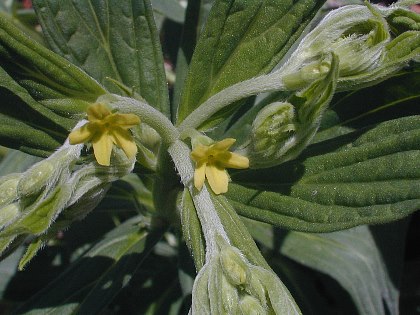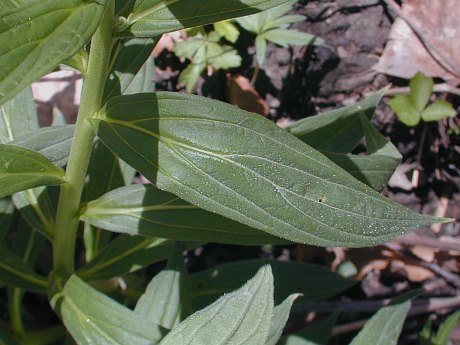Description: This perennial plant is about 1½–2½' tall, branching occasionally. The stems are light green and densely covered with white hairs. The alternate leaves are up to 5½" long and 2" across; they are lanceolate to ovate, smooth along the margins, and sessile. The upper surface of each leaf is dark green, sparsely covered with short hairs, and pinnately veined; the lower surface is light green and densely covered with short white hairs. The lateral veins are conspicuous on both sides of the leaves. The flowers bloom near the apex of the stems. They occur individually from the axils of the leaves; their pedicels are short. Each flower is about ¼" across, consisting of a hairy green calyx with 5 linear-lanceolate teeth and a pale yellow corolla with 5 spreading lobes and a narrow throat. The tube of the corolla is no longer than the teeth of the calyx. The reproductive organs are hidden within the corolla. The blooming period occurs from mid-spring to early summer. Only a few flowers are in bloom at the same time. They are replaced by ovoid-globoid nutlets with an outer coat that is white, smooth, and hard. The root system consists of a taproot, which may send up more than one stem.

Cultivation:
The
preference is dappled sunlight during the spring and light to medium
shade during the remainder of the year. The soil should be moist to
slightly dry, fertile and loamy, containing abundant organic matter.
The hard white seeds are difficult to germinate.
Range & Habitat:
The native American Gromwell is scattered across Illinois; it is an
uncommon plant
(see Distribution
Map). Populations of this species within the state have
probably declined. Habitats include rich deciduous woodlands, wooded
slopes, and shaded riverbanks. This conservative species prefers high
quality woodlands where the original ground flora is largely intact.
Faunal Associations:
The structure of the flowers suggests that the pollinators are
long-tongued bees and butterflies. More specific information about
floral-faunal relationships is currently unavailable.

Photographic
Location:
Toward the bottom of a moist wooded slope in Vermilion County,
Illinois.
Comments:
American Gromwell is one of the woodland wildflowers that blooms during
the spring, but it is often overlooked and many field guides fail to
describe it, probably because its flowers are not very showy. American
Gromwell resembles Lithospermum officinale
(European Gromwell) in its overall appearance. This latter species
produces flowers in flat-headed cymes and its leaves are more slender.
In contrast, American Gromwell produces individual flowers from the
axils of the leaves. Another European species, Buglossoides
arvense (Corn Gromwell), produces individual flowers from the
axils of the leaves, but these flowers are bright white and its leaves
are smaller in size. Corn Gromwell produces nutlets that are brown and
wrinkled, rather than smooth and white. Other Lithospermum
spp. in Illinois are native prairie plants that also produce
flowers in flat-headed cymes. The flowers of these latter species have
longer corollas that are a brilliant yellow or orange-yellow.